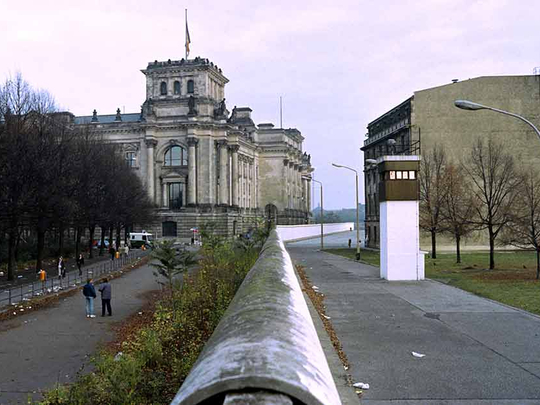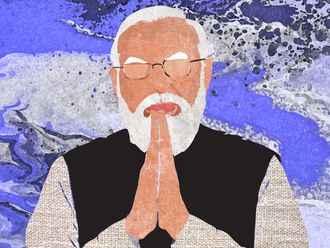
The east-west divisions that still exist in Germany 25 years after it reunited no longer look unbridgeable — except perhaps one, which has to do with the top item on today’s political agenda: immigration.
In the first seconds of October 3, 1990, the German flag was hoisted in front of the Reichstag building in Berlin and fireworks crisscrossed the sky, as people celebrated the country’s unification. The Federal Republic of Germany swallowed up the former German Democratic Republic, acquiring what are still called the “neue Bundeslaender,” or new federal states: Brandenburg, Mecklenburg-Vorpommern, Saxony, Saxony-Anhalt and Thuringia. The new Germany also reincorporated the city of Berlin, not even the western part of which was included in the Federal Republic.
It didn’t seem like too big a bite to swallow. The east (not including Berlin) had a population of 14.5 million, compared with about 61 million in the rest of Germany. Sure, it was badly off economically, accounting for just 11 per cent of German gross domestic product in 1991, but why wouldn’t the economic difference level out now that borders were gone?
It hasn’t quite, despite $2 trillion (Dh7.34 trillion) in west-east economic aid. Not that the money was wasted: Thuringia’s economy almost doubled in the last quarter-century and none of the new states grew by less than 60 per cent. Yet the former East Germany has lost 14 per cent of its population to the west, and still produces just 15 per cent of the country’s GDP. Unemployment, at about 12 per cent, is twice as high as in the rest of the country. The Communist legacy of value destruction turned out to be more difficult to erase than anyone had foreseen.
East-west migration
Perhaps, however, the gap doesn’t need to be fully closed. One could argue that the important things have evened out: For example, east-west migration is now balanced, and life expectancy — at least for women — is practically the same in eastern and western states. According to a recent study by the Berlin Institute for Population and Development, the same consumer brands and even the same national media are popular in the east and in the west.
Easterners, or “Ossies,” are somewhat less business-oriented and have a greater tendency to support leftist politicians, but the remaining economic and cultural divide is probably no more dramatic than the one between, say, the eastern and southern states of the US, or northern and southern Italy. And east Germans certainly identify more with the rest of the country than do Scots with the rest of the UK, or Catalans with the rest of Spain. A meaningful, separate east German identity no longer exists.
There is, however, one pronounced gap that hasn’t been closing. In the postwar years, relatively open western Germany saw an influx of immigrants, including millions of “guest workers” mostly from Turkey, but also from southern Europe and North Africa. Many stayed, though they weren’t originally supposed to — unlike workers from other Communist countries, who came to work in East German factories for a time and unfailingly were sent back. And after unification, new immigrants to Germany continued to be attracted to the more prosperous western states.
Destatis, Germany’s official statistical agency, recently put out a report dedicated to the 25th anniversary of reunification. It has a number of maps, and east-west convergence is evident on most of them. There is one, however, that shows a clear border — just like pre-1990 political maps did: The one that shows the distribution of Germany’s immigrant population.
The few immigrants who have settled in the eastern states — many as a result of intercultural marriages — stick out like sore thumbs. It’s harder for them to find work and more depend on the state, although they are, on average, better educated than immigrants in the western part of Germany: That creates a vicious circle: Locals don’t want to see more foreigners in their town, and they fear the weak social safety net in their part of Germany will tear if too many arrive. Dresden, the capital of Saxony, last year became the centre of a noxious movement against “the Islamisation of the West,” known by its German acronym, Pegida. Government officials including Chancellor Angela Merkel heaved a sigh of relief when the movement imploded, after its leader posed for a photograph styled as Hitler, but the anti-immigrant sentiment didn’t disappear. Now, if a German news site reports that a refugee shelter has been set on fire, it is likely to have happened in the east.
In western Germany, according to a recent poll, 44 per cent support and 46 per cent oppose Merkel’s policy of welcoming asylum seekers from the Middle East, while in the east, only 31 per cent approve of Merkel’s actions and 56 per cent oppose them.
Paradoxically, the eastern lands need immigrants the most; their populations are ageing faster than in the west, because their birth rates are lower. The government is trying to disperse this year’s enormous influx of refugees more or less evenly throughout the country, but establishing all of Germany as a country of immigration may well be the biggest challenge the nation has faced since it became one again. This challenge has fallen to Merkel — herself an Ossie — and her success in dealing with it will determine her legacy more than any other task she has confronted.
— Washington Post
Leonid Bershidsky, a Bloomberg View contributor, is a Berlin-based writer.











